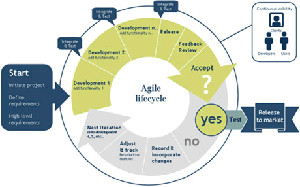Although the Scrum agile methodology was originally formalised for software development projects, as with other agile frameworks it can be applied well to any complex, innovative project that a team works on.
Scrum is a way for teams to work together to develop a product where product development occurs in small pieces, with each piece building upon previously created pieces. Building products one small piece at a time encourages creativity and enables teams to respond to feedback and change, to build exactly what is needed using a most efficient manner.
Furthermore it’s a simple framework for effective team collaboration on complex projects that provide a small set of rules that create just enough structure for teams to be able to focus their innovation on solving what might otherwise be an insurmountable challenge.
So let’s have a look at how scrum methodology can be applied, and its potential benefits and challenges, when applied to embedded systems and hardware projects. Building complex products for customers is an inherently difficult task, even more so for projects that have a hardware component, and Scrum provides structure to allow teams to deal with that difficulty.
However, the fundamental Scrum process is quite simple and at its core it is governed by a few core roles on the project team. Product owners determine what needs to be built during a “sprint” interval of 1 to 4 weeks and the development team does the technical work to design and build what is needed during this interval, followed by demonstration of what they have built.
Based on this demonstration, the product owner determines what to build next. The Scrum master ensures this process happens as smoothly as possible and continually helps to improve the process.
A key principle of Scrum that differentiates it from traditional project management philosophies is its recognition that during a project the customers can change their minds about what they need or want, and that unpredictable challenges cannot be easily addressed in a traditional predictive or planned manner.
As such, scrum methodology adopts an empirical approach, accepting that the project cannot be perfectly understood or defined in advance and instead the team focuses on maximising its ability to deliver small iterations of progress quickly and to respond to changing or emerging requirements as the project proceeds.
As the team proceeds through the “backlog” of tasks during a scrum project, it is accepted that changes can and will happen – the team may learn about new market opportunities to take advantage of, competitor threats that may arise, or customer feedback may change the way the product is supposed to work.
When it comes to hardware projects, the time constraints involved in fabrication of printed circuit boards, the ordering of components, hardware assembly or other external manufacturing dependencies and the commitment to a particular hardware prototype design once it has been sent for manufacturing can potentially make it much more difficult to respond to new or changing customer specifications or requirements within the fixed timeframe of a given sprint.
If these kinds of factors in ordering or manufacturing hardware devices exceed the time allocated for a sprint, these manufacturing issues can present a unique challenge when trying to apply agile methods to hardware development.
The “sprint” is the basic unit of development effort in a Scrum project, a period of typically 1 to 4 weeks in which development occurs on a set of “backlog” items that the team has committed to, restricted to a specific time duration which is fixed in advance for each sprint.
Over the course of a sprint the project team has a physical, co-located, “stand-up” meeting every day to communicate between the team and assess its work, while the scrum master keeps the team focused on its goal along the way.

For hardware projects, increasingly popular and accessible tools and technologies such as small-scale CNC milling, 3D printing, and laser cutting are becoming more important for rapid prototyping and agile hardware development, allowing components such as custom plastics or simple PCBs to be rapidly prototyped, demonstrated to the product owner and evaluated within a sprint.
A prototype iteration of a hardware system doesn’t have to physically involve hardware. Simulation and visualisation tools, such as SPICE for electronic engineering, 3D rendering of mechanical components and PCB component dimensions, and thermal modelling for predicting heat transport with a device enclosure, for example, can all play an important role in assuring the quality, interoperability, industrial design, electrical and thermal performance and the “look and feel” of all the components that come together into a new product even before a prototype is actually physically constructed.
These tools and techniques can also be valuable to demonstrate hardware design and engineering progress relatively quickly, within the finite timeframe of a sprint, if the manufacturing of physical prototype hardware will take longer.
Once again this shows that agile can be used effectively with embedded (and other) hardware development if all members of the team embrace the methodology. And that includes the engineering team here at the LX Group – who can bring your ideas to life.
Getting started is easy – join us for an obligation-free and confidential discussion about your ideas and how we can help bring them to life – click here to contact us, or telephone 1800 810 124.
LX is an award-winning electronics design company based in Sydney, Australia. LX services include full turnkey design, electronics, hardware, software and firmware design. LX specialises in embedded systems and wireless technologies design.
Published by LX Pty Ltd for itself and the LX Group of companies, including LX Design House, LX Solutions and LX Consulting, LX Innovations.

 apid Application Development or RAD.
apid Application Development or RAD.